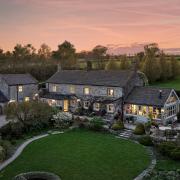Hats off to Ilkley... And boots on as we explore this wonderful West Yorkshire town on foot

Ilkley is a gem of a town with riches aplenty, from lovely cafes and independent shops to the stunning surrounding countryside, which provides cyclists and walkers with heavenly earthbound opportunities.
There are lots of reasons to visit this wonderful place but you don’t always have to head for the usual tourist haunts. In fact, you could follow in my contrary footsteps and take the road less travelled around this West Yorkshire spa town.
First on my itinerary after leaving the train station was a stroll through leafy suburbs to the junction of Middleton Avenue and Denton Road. Here, standing proudly in red, is Yorkshire’s rarest pillar box – and what an absolute beauty she is! The elegant grade two listed relic dates from 1866 and features a hexagonal box topped with an acorn. It is one of only 20 of its kind in the UK and looks quite different to Royal Mail’s modern cylindrical varieties.
A little bit of research tells me that novelist Anthony Trollope recommended trialling the very first pillar boxes as a young civil servant. They were initially installed in Jersey in 1852 before being rolled out to the mainland. Ilkley’s remains a prime working example and earns my very highest stamp of approval for quirkiness as well as combining form with function.

Having already puzzled passers-by by taking photographs of a pillar box, I made another odd detour, this time to meet some sheep. Three years ago, a giant Ilkley mural called the Story of Wool was given listed status by Historic England. Made from glass-reinforced plastic, it adorns the front of the former International Wool Secretariat building and was first unveiled in 1968. The stylised sheep look really striking with their curled horns, cloven hooves and thick fleeces.
The secretariat has long gone, but the mural reminds us of the mighty woollen trade that made the West Riding a global powerhouse. Public art fans (as well as sheep fans) will love it.
Walking back into town, I mused that Ilkley has come a long way since 1820, when it was described as ‘one of the most rustic, inaccessible and primitive little places in the country (with) streets full of ruts … and lined by stinking refuse’.
All that changed with the Victorian fashion for hydrotherapy and the trend for taking the local spa waters. It was boom time in Ilkley; an upswing heightened further by the arrival of the railway, which transformed the tiny settlement into the self-styled ‘Heather Spa’, with a VIP visitor list including Charles Darwin.
The town has never looked back and has become a byword for a particular kind of Yorkshire elegance best summed up in Alan Bennett’s hit comedy A Private Function, filmed in the town in the 1980s and recounting the story of an upwardly mobile chiropodist with a shop on the coveted ‘Parade’.
Of course, the town has also done quite well for itself by having its name in the title of the Yorkshire anthem ‘On Ilkla Moor Baht ’At’. Humming its tune (also used for an early version of the carol ‘While Shepherds’), I set off to sample the wild moorland’s delights, well wrapped up against the chilly day.
Ilkley Moor is part of Rombalds Moor, where signs of human occupation go back thousands of years. Some of these early dwellers, who lived before the pyramids were built, left behind cup and ring symbols and other petroglyphs carved into stones. There are more than 400 of them – the second highest concentration of their type anywhere in Europe.
Are they territory markers, religious symbols or just very old graffiti? No one really knows, but we can still rejoice in their continuing survival, helped by each having its own GPS tag so they can be identified in the landscape and their condition monitored.
The Friends of Ilkley Moor is just one of the many organisations active in conservation locally. It has just completed a successful two-year project, the Big Ilkley Moor Survey, which was granted £50,000 by the Heritage Lottery Fund to collect data on the flora and fauna of the moor and the state of its peat bogs.
A key aim was to get locals involved and teach them how to carry out similar surveys. In the end, more than a thousand people took part, along with 30 different organisations. All their findings are currently being collated for inclusion in an upcoming report.
Future work on the moor could include a consortium of universities taking deep peat core samples to help establish weather patterns and to discover what grew in the district thousands of years ago. It’s also possible that drainage ditches discovered on the upper slopes during the survey will be blocked, enabling the peat to retain its water and stay healthy.
A place as iconic and beloved as Ilkley Moor is always likely to arouse strong feelings. Last year, for example, Bradford Council’s decision to end grouse shooting attracted a hail of opinion from all sides.
But one thing we can surely all agree on is that this is a wild and special place; one we have shared with Mother Nature for thousands of years and will continue to do so for generations to come.
Which means, of course, that when you visit Ilkley, make sure you bring your walking boots – especially if you want to follow in my footsteps along the road less travelled from pillar box to moor top.



























